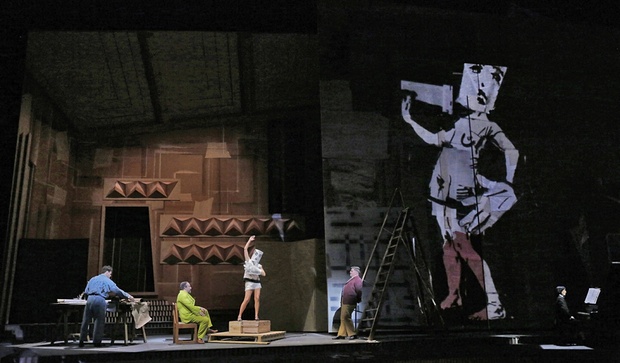Which is what I did (though I did have eyes for the dance both times). (Vera went to the first show.)
The absolute highlight of the program was Vancouver-based Crystal Pite's "Polaris", set to the orchestral score of the same name. This piece featured 66 dancers dressed in black; they filled up the entire stage. Pite worked at times like a sculptor, creating moving masses of undulating bodies. Huge groups of bodies gathered in clumps, dispersed into chaos, and then suddenly stopped in a striking new formation. Sometimes they looked liked rows of dominos falling. The lighting design was equally amazing; sometimes all you saw was 66 pairs of illuminated hands. The whole thing felt a little like some kind of science fiction/ post-apocalyptic scenario. The music is somewhat atypical for Adès; clear lines in the brass predominated, and the music had an almost heroic, epic feel to it. There were brass instruments scattered around the hall, as well. At first hearing it seemed bombastic, like a film score for a Hollywood epic; much less so on the second hearing. In both performances the audience response was tremendously enthusiastic; they should really try to mount this elsewhere, it's a real crowd pleaser in the best sense. A truly memorable experience.
Some pictures from the web, though none of them can convey the feeling of seeing so many dancers move on stage.
The Piano Quintet is a fascinating piece. It's written in sonata form, with a repeat of the exposition no less. It is also fiendishly complex rhythmically; one section I noticed in the score had the piano playing in septuplets filling ⅗ bars while the strings are playing quintuplets in 4/4 bars. (Sorry for the details, non-musicians!) Not the kind of rhythm you might write if you were composing a piece for dancers to count! It also constantly evokes the sounds and textures of classical piano quintets, but in very different contexts. Christopher Whitley's choreography, set on three dancers, seemed rather subservient to the music, which in fact was not a bad thing, as it clearly outlined the large scale structures of the piece. Balanchine, of course, was famous for saying that the purpose of the choreography in some of his pieces was to simply illustrate the music, but it takes a choreographer who is also a virtuoso musician to sometimes make this work. But I did feel that the choreography added to the experience of the music.
Karol Armitage's piece "Life Story" was set to a song for soprano and piano, using a Tennessee Williams text about two first night together post-coital lovers getting to know each other. Essentially, the two dancers on stage were competing with a live singer and a text; I found it hard to focus on the dancers; instead both my eyes and ears were drawn to the singer.
The first piece on the program was choreographed by Wayne McGregor to the Violin Concerto. This is one of Adès's most typically complex scores; McGregor's choreography does not intend to explore the musical details of the score, but instead creates a kind of emotional counterpoint to the music. I found the movement interesting, but not particularly illuminating, though I can imagine a dance oriented person would have been more excited. The music is dense and intricate; my ears demanded all the attention.
Alastair Macaulay, the musically sensitive dance critic for the NY Times, thought that the choreography for the program as a whole was not worthy of the complexity and sophistication of Adès's music. While I agree with him in some ways, I do think that it is an almost impossible task to create a choreography which would perfectly mirror the complexity of the music. Macaulay, I think, is thinking of the Balanchine-Stravinsky masterpieces, the likes of which we may never see again. The thing that surprised me as a whole, though, is actually how well Adès's music actually works with dance, especially given that none of it was conceived for dance.
Speaking of complexity, the next night we went to hear the music of Mr. Complexity himself, Elliot Carter. The Juilliard Quartet was playing his first string quartet. Performances of Carter's music have become quite rare now after his death three years ago, now that the novelty of the 103 year prodigy creating new pieces has worn off. The first string quartet, composed in 1951, is when Carter became Carter, the composer of complexity. The performance was a knockout, played with great intensity and commitment. Carter's innovation during this period was to have each player play with very independent lines and rhythms; we don't hear ensemble playing, but rather four different parts that often clash with each other. Hearing the quartet live really brought out the independence of each player's part; I was totally involved for every minute of the quartet's 45 minute length. Hearing the Carter right after a sustained exposure to Adès was revelatory. While both write music of complexity, Adès enjoys references to all kinds of musical styles, while Carter seems to write very deliberately without the even slightest reference to any traditional melodic or rhythmic sonorities.
The program also began with Schubert's "Quartetsatz" (not Haydn!) and concluded with a sensuous and very expressive rendition of Debussy's string quartet, which normally is played with a more mellow, "impressionist' kind of character.








